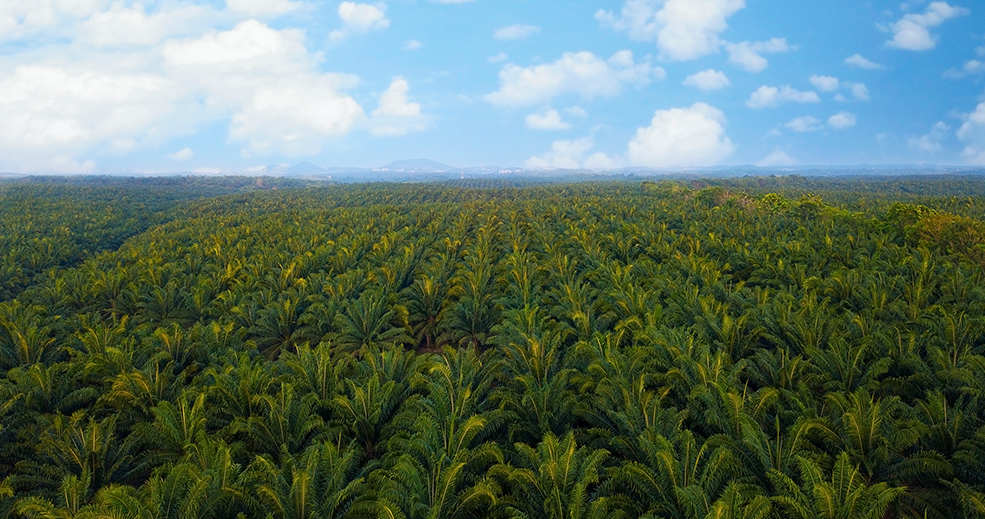
Indonesia : the war in Ukraine is aggravating the palm oil crisis
Soaring palm oil prices in Indonesia exemplify the kinds of indirect (or “second-round”) effects a crisis – in this case the war in Ukraine – can have on even a faraway economy whose trade structure has few links to the conflict zone.
This phenomenon is highlighting consumer behaviours, value chains and the complementarity or substitutability of some products. The contagion is not confined to Indonesia: it is now affecting the country’s customers – chief among them India and China, both of which import huge amounts of Indonesian palm oil. Collateral damage from the conflict is as yet far from fully visible, let alone under control.
Markets got carried away last week after the Indonesian government announced a surprise embargo on exports of palm oil – of which the country is by far the world’s leading exporter – on 22 April. Palm oil was trading on the Koala Lumpur Stock Exchange at $1,700 a tonne (compared with $1,300 at the beginning of the year), while the Indonesian rupiah, although relatively unaffected by pressure on emerging currencies, was trading at over 14,400 to the dollar (up from 14,250 in January).
Palm oil prices had already begun to rise before the conflict but surged in March when exports of Ukrainian sunflower oil were blocked. Back in January, the government had already ordered producers to reserve 20% of their output for the domestic market and instituted a price freeze; this quota was raised to 30% in March before being replaced by an export tax. However, as the end of Ramadan and its celebrations – when demand for cooking oil increases sharply – approached, President Joko Widodo, known as Jokowi, decreed the embargo, not wanting to take any risks. He would like cooking oil to stabilise at around 14,000 rupiah a litre, 30% below its current price.
Controlled inflation thanks to subsidies
Compared with the rest of the world, inflationary pressures have been kept in check in Indonesia. Price inflation has quickened, rising from 2.1% year on year in February to 2.6% in March, very close to the level of core inflation (2.4% in March), which remains within the central bank’s target range (3% ± 1%), enabling the latter not to hike interest rates (4%) despite US monetary tightening.
In reality, this is the result of a policy of subsidies and price control for both energy (coal, oil) and food (cooking oil, sugar, soya, eggs). This policy, hitherto financed by the higher prices of exported commodities (coal, palm oil, metals), has enabled the country to consolidate its foreign currency reserves (enough to cover around eight months’ imports) and build up a record trade surplus ($39 billion).
The freeze on palm oil exports (which account for around 10% of Indonesia’s total exports) is thus depriving producers – and, above all, the state – of considerable inflows of foreign currency, while Indonesia is also dependent on the outside world for some commodities (notably oil, soya and wheat).
An imperative: the golden rule of fiscal policy
This is a difficult circle for President Jokowi – whose approval ratings have fallen sharply and who has a multitude of constraints to reckon with – to square. Supposing the export ban fails to bring down palm oil prices or inflation surges through other channels, the subsidy policy could also run afoul of fiscal principles enshrined in Indonesian law, which lay down a golden rule according to which the budget deficit may not exceed 3% of GDP.
While this rule was bent in 2020 to finance exceptional Covid-19-related measures, the Finance Act calls for the deficit to be brought back below 3% by 2023. In 2021, the deficit came in at 4.65% of GDP, well below the official estimate of 5.7%, thanks to a big increase in receipts linked precisely to the export sector.
Investors are keeping a very close eye on the country, long considered one of the “usual suspects” ever since the 1997 crisis and the rescheduling of both public and private debt. Another potential cause for concern is the overly lax use of monetary policy (monetary financing of the deficit), which raised questions among analysts during the Covid-19 crisis. The government is thus determined to do everything in its power to avoid setting up a vicious circle in which a reversal in the trade balance could put exchange rates under severe pressure, forcing the central bank to intervene.
Indonesia – which, relatively speaking, has less debt than its neighbours, with public and external debt of around 40% of GDP – is not the country most at risk of such a reversal. The fact remains, however, that such a nightmare scenario would further undermine the Indonesian economy, which still bears the scars of past crises.







